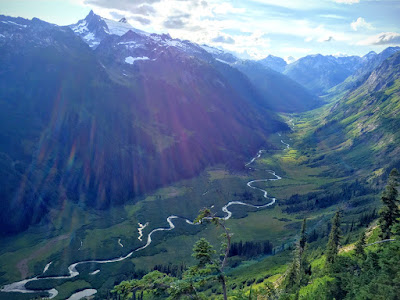The High Pass High Route is described on pages 112-114 in the classic text Routes and Rocks by D.F. Crowder and R.W. Tabor (well worth a look if you're unfamiliar) but more recent instructions can be found in this excellent NWHikers trip report. The "steep snow gully about 50 feet wide" immediately north of High Pass that's referenced in Routes and Rocks has historically been a route hazard that persisted through the summer and the prevailing wisdom was to always carry an ice axe when crossing High Pass. In more recent years, this snowfield has been melting out sometime in late summer and is of no concern at that point, though it may still merit carrying an ice axe earlier in the summer.
The climb to Little Giant Pass from the Napeequa Valley is a notoriously steep, rough, and brushy trail, though ascending it shouldn't pose any more of a problem to experienced travelers than High Pass does. I wouldn't recommend descending from Little Giant Pass to the Napeequa, though I have encountered people doing it and it can be done. In 2009, two horses fell to their deaths while descending from Little Giant Pass to the Napeequa Valley.
Distance: about 31 miles
Elevation Gain: 8,500-9,000'-ish
Maps and More:
- 1x31680 scale (1 inch = 0.5 mile) for the on trail portions and 1x24000 scale for off trail
- Mileage, elevation gain, and route details
Overview Map:
Trailhead:
Entering Glacier Peak Wilderness
Helmet Butte coming into view
Glacier Peak from near Buck Creek Pass
Glacier Peak and the Dakobed Range
Approaching High Pass
High Pass, the route goes across the slope on the left side
Triad Lake
Beginning the descent from High Pass to the Napeequa Valley
Muddy marmot tracks
Continuing the descent to the Napeequa Valley
Getting views of Clark Mountain and the eastern end of the Dakobed Range
Closer view of Clark Mountain
First look downstream the Napeequa Valley
Louis Creek
Clark Glacier up close
Looking back upstream along the Napeequa River
The Napeequa Valley: as pretty as an Alaskan glacial valley and almost as brushy
Beetle-killed trees (the brown stands) above the Chiwawa River valley
More info:
Luke's excellent trip report from October 2014


















